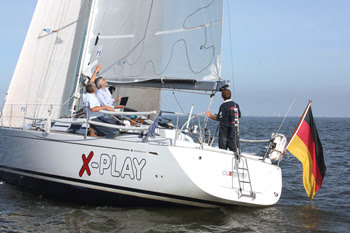
Fiber optic sensors set sail
To win races through wind, waves and inclement weather, sailors need nerves of steel. But it turns out that their boats need “nerves of glass.”
A new fiber optic sensor system for racing yachts could alert crew members when a craft reaches its structural limits. Such a system is designed to measure in real time the oceanic forces that act on hulls, masts and sails.
The process for optimizing the yachts for high speed on the open seas has been ongoing. Still, yacht racers see the need for improvement: Only one of the six teams in the 2012 Volvo Ocean Race from New Zealand to Brazil reached its destination; the others were sidelined with technical problems.
“These boats are very well constructed,” said Ian Walker, skipper of the Abu Dhabi Ocean Racing team. “I just think we put too much strain on them, and since they are so rigid and so light, it’s hard not to believe that they ultimately must break.”

A fiber optic system fitted to a racing yacht could warn sailors of structural weak points and let them know if their vessel is in imminent danger of breaking apart.
The sensor system is in development by Wolfgang Schade and his team in the Project Group for Fiber Optical Sensor Systems at the Fraunhofer Institute for Telecommunications, Heinrich Hertz Institute in Munich. The technology is based on integrating fiber Bragg gratings into glass fiber at defined intervals to alter the refractive index.
“With fiber optic sensors, we can detect delaminations and even cracks at any early stage – long before a part breaks or fails,” Schade said. “All you need is a fiber optic cable, in which dozens of sensors can be fitted.” The equipment includes the sensors, an LED, a spectrometer and electronics.
Sailors will be able to access crucial structural data in real time with specially developed apps on their smartphones from any point on the vessel.
To demonstrate the system, sail manufacturer Dimension-Polyant fitted a web of glass fibers containing 45 measuring points to a mainsail and genoa on a boat in the sailing workshop of Jens Nickel, whom Schade met at a boat fair. A test journey revealed that tension in the head, at the top of the sail, was greater than had been assumed and that the strain on some other parts of the sail was lower than expected. The sail maker adjusted the production process accordingly.
Schade’s next objective is to adapt the technology to competitive racing. “We have now fitted sail battens with fiber optic sensors, which will help competitors in the future to find the optimal trim,” he said.
Published: September 2012